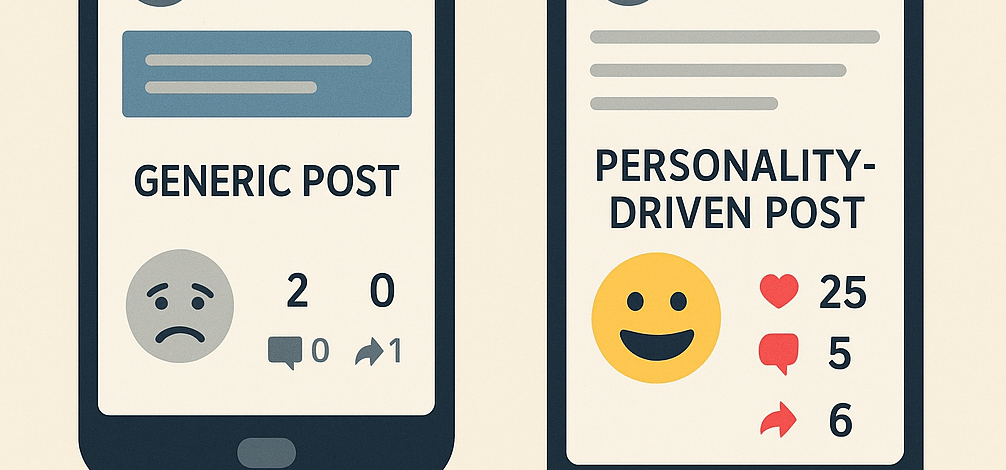Why Personality-Driven Government Content Wins: The Data Behind Authentic Social Media
Government social media doesn't have to be boring to be professional. Develop an authentic voice that boosts engagement rates while maintaining credibility.
10/10/20255 min read


Bottom Line Up Front: Generic government social media posts earn significantly lower engagement rates than personality-driven content. With government accounts averaging just 2.32% engagement on Facebook and similar rates across platforms, the data shows that playing it safe is actually the riskiest strategy. Authentic, distinctive voices aren't just nice to have—they're essential for reaching your community.
Every government communicator knows the feeling: you've crafted what you think is a perfectly acceptable social media post. It's informative. It's accurate. It's properly vetted. You hit "publish" with confidence.
And then... crickets.
Meanwhile, down the hall, the recycling department's cheeky meme about pizza boxes gets 10 times the engagement. What gives?
The Data Doesn't Lie: Generic Content Falls Flat
Recent benchmarking data reveals an uncomfortable truth about government social media: even when we post frequently, we're often not connecting with our audiences. Government accounts on Facebook post an average of 16 times per week, yet the highest engagement rate—just 2.32%—comes from posting only twice weekly. On Instagram, it's 4.21% with the same frequency.
What's happening here isn't a volume problem. It's a voice problem.
Research shows that 77% of consumers are more likely to engage with content that feels genuine and relatable. Yet most government posts are written in what we might call "bureaucrat-ese"—technically correct but emotionally flat. We opt for phrases like "The Department wishes to inform residents" when "Hey neighbors, quick update" would resonate far better.
The hidden cost? Every generic post isn't neutral—it's actively training your audience to scroll past your content.
What We Lose When We Play It Too Safe
Lost Reach: Social media algorithms prioritize content that generates engagement. When your posts consistently fail to spark interactions, the algorithm learns to show your content to fewer people. Your 5,000 followers might see the post, but if they don't engage, your next post will reach even fewer. It's a downward spiral that starts with playing it safe.
Lost Trust: Contrary to what many believe, overly formal communication doesn't build credibility—it creates distance. When government accounts sound like press releases rather than people, residents begin to view them as broadcasting stations rather than community members. Research on authenticity in social media consistently shows that genuine, transparent communication builds deeper trust than polished corporate-speak.
Lost Opportunities: Generic content misses chances to showcase the humans behind the work. Your planning department isn't just processing permits—someone on your team is helping a family open their dream restaurant. Your public works crew isn't just filling potholes—they're making school routes safer for kids. These stories matter, but they disappear in generic messaging.
The Frederick County Formula: When Personality Meets Purpose
As we explored in our recent post on government edutainment, Frederick County, Maryland's Division of Solid Waste & Recycling provides a masterclass in balancing personality with professionalism. Their social media presence is friendly, occasionally irreverent, and grounded in useful information.
What makes their approach work isn't just humor—it's consistency and authenticity. They've developed a recognizable voice that residents trust, which means when they need to share important information about hazardous waste disposal or new recycling guidelines, people actually pay attention.
The lesson? Personality isn't the opposite of professionalism. Done right, it's what makes your professional content actually reach people.
The Risk Assessment Framework: Finding Your Voice Safely
The biggest barrier to developing a distinctive voice isn't capability—it's fear. Fear of making mistakes, facing criticism, or going "off brand." But there's a framework for managing this risk while still developing authentic communication:
Level 1: Low-Risk Personality Injections
Start here if you're nervous about making changes:
Use conversational language in standard updates ("Here's what you need to know about street sweeping this week")
Add relevant emojis sparingly but strategically
Ask simple questions to invite engagement ("Which local trail is your favorite?")
Share behind-the-scenes photos with brief, friendly captions
Level 2: Moderate-Risk Distinctive Content
Once you're comfortable with Level 1:
Create content series with recurring themes or formats
Use mild humor related to common community experiences
Share staff spotlights that reveal personality
Participate in appropriate trending topics or awareness days
Post "did you know" facts about your jurisdiction with surprising details
Level 3: Higher-Risk Bold Moves
For accounts that have built trust and tested their voice:
Engage playfully with other government accounts
Create memes relevant to local issues (with appropriate sensitivity)
Post timely reactions to community events in real-time
Develop a distinctive visual style or content format
Address challenging topics with honesty and transparency
Critical caveat: Even at Level 3, there are clear boundaries. Personality should never come at the expense of accuracy, respect, or sensitivity to serious issues. When sharing information about emergencies, public safety, or contentious policy decisions, clarity and directness matter more than cleverness.
Practical Steps: Developing Your Voice This Week
You don't need to overhaul your entire social media presence overnight. Start small:
Audit your last 10 posts. Which ones got the most engagement? What did they have in common? Most likely, the winners had more personality, asked questions, or shared something visually interesting.
Define 3-5 voice attributes. Are you helpful? Friendly? Straightforward? Community-focused? Write them down. These become your guardrails.
Rewrite one standard post. Take your most common post type (meeting notices, service updates, etc.) and rewrite it with your voice attributes in mind. A/B test the generic version against the personality-driven version.
Get internal buy-in. Share engagement data with leadership. Show them that personality-driven content from other government accounts isn't risky—it's effective. Use examples from respected agencies.
Create approval guidelines, not barriers. Rather than requiring every post to go through multiple approvals, develop clear guidelines for what's pre-approved (conversational tone, appropriate humor, behind-the-scenes content) and what needs extra eyes (controversial topics, emergency communications, policy statements).
The Bottom Line
Generic government content isn't just boring—it's expensive. Every post that gets ignored is a wasted opportunity to build trust, share important information, and strengthen community connections. In an era where attention is scarce and algorithms punish low engagement, playing it safe is paradoxically the riskiest approach.
The good news? You don't need a bigger budget, a larger team, or fancy tools to develop a more engaging voice. You just need permission to sound like the helpful, knowledgeable humans you are.
Your community isn't looking for perfection. They're looking for authenticity. And that's something every government communicator already has—we just need to let it show.
Ready to develop a more authentic, engaging social media presence? At Public Square Analytics, we help government agencies and public officials create data-driven communication strategies that balance personality with professionalism. Our VoxiFly tool provides recommended posts tailored to your voice and community, while our custom dashboards show you what's working for similar organizations. Contact us to learn more about how we can support your social media goals.
What's your biggest hesitation about adding more personality to your government communications? Drop a comment below—we'd love to hear from you and continue this conversation.
